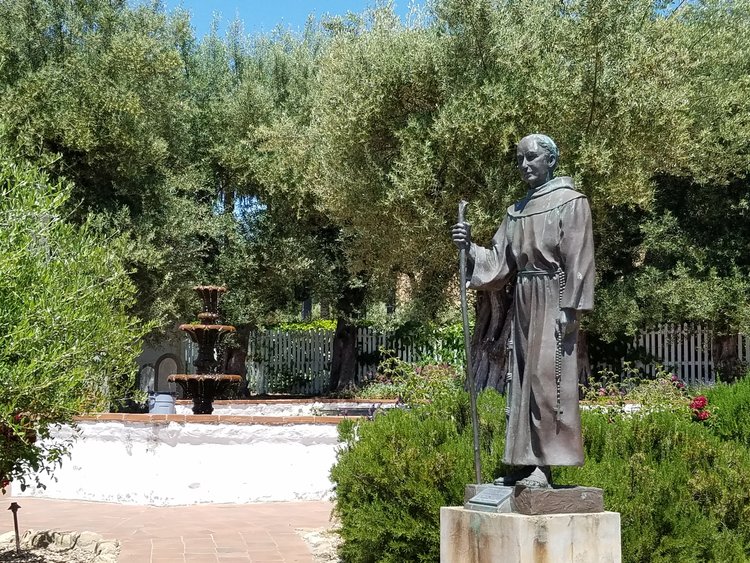Did you know?
The Old Mission San Jose receives no sustaining support from any governmental agency. We are grateful for any and all donations received. Donations are used for preservation, maintenance and to keep the Mission operating. Your tax deductible donation to Mission San Jose provides funds for preservation of this historic landmark.
You may add a note ‘In memory of’ or ‘In honor of’ in the comments box when you donate.
*Mission San Jose is a 501(c)(3) non-profit organization. Donations are tax deductible to the full extent of the law.
How your donation helps

Care for our facilities
The original adobe church, destroyed by earthquake in 1868, was reconstructed in 1985 over the original foundation. After more than 35 years of exposure to the elements, you can help us restore the Church’s exterior.

Enhance our Museum
The Mission San Jose Museum welcomes almost 10,000 visitors each year, 3,000 of whom are 4th graders studying California history. Help us improve the educational experience for all through new exhibits, multi-media, and hands-on activities.

Maintain our Grounds
Our historic cemetery and peaceful Patio Garden require constant attention such as maintenance of 200+ year old olive trees, repair of adobe walls and replacement of cracked tiles. Your donations help keep our grounds looking beautiful.
Ways to give
Online
We accept donations and support for all levels. Make a donation in any amount and your name will be listed in our “Friends of Mission San Jose” Donor List.
By Check
To support our efforts to maintain the historic Mission San Jose by check, please send your check payable to:
Mission San Jose
P.O. Box 3159
Fremont, CA 94539
We can also accept donations at the Gift Shop.
Stock, Mutual Funds, or IRA Distributions
By donating publicly traded appreciated stocks or shares of mutual funds to Mission San Jose, you can avoid paying capital gains taxes and receive a tax deduction if you itemize deductions on your tax return.
Owners of traditional IRAs who are 70 ½ and older can donate all or some of their annual IRA Required Minimum Distribution to Mission San Jose.
See the details below on how to make these types of donations.
Committee for Restoration of Mission San Jose
CRMSJ was formed in 1975 as a secular, non-profit corporation to solicit, receive, and maintain funds to use and apply specifically to the restoration of the Mission San Jose. When major rehabilitation and maintenance projects exceed the available funds, this committee strives to support the needs of the Mission through fund-raising and coordinating volunteers. Click HERE to learn more or donate.
SUPPORT MISSION SAN JOSE BY DONATING STOCK, MUTUAL FUNDS, OR IRA-REQUIRED DISTRIBUTIONS
By donating publicly traded appreciated stocks or shares of mutual funds to Mission San Jose, you can avoid paying capital gains taxes and receive a tax deduction if you itemize deductions on your tax return.
Owners of traditional IRAs who are 70 ½ and older can donate all or some of their annual IRA Required Minimum Distribution to Mission San Jose and avoid paying income tax on the donated amount. The donation must be made directly from your IRA to the parish to avoid having it count as taxable income. Consult your tax advisor and IRS Publication 526, Charitable Contributions, for more information.
Step 1 – Go to: https://www.oakdiocese.org/how-to-give. Print and complete the Diocese’s online Security Donation Form requesting your broker transfer a certain number of shares of a company or a mutual fund from your investment account or IRA to the Schwab brokerage account of the Roman Catholic Bishop of Oakland. Be sure to indicate your gift is for Mission San Jose- Fremont.
Step 2 – Submit the original of the completed Security Donation Form to your broker and email a copy of the completed form to John Pluth in the Diocesan Finance Department at jpluth@oakdiocese.org and to Gina Mehta at gmehta@saintjosephmsj.org.
Step 3 –Mission San Jose will send you a letter acknowledging your donation. You should also keep a copy of the letter and your broker’s record of the value of the securities at the time of transfer which typically is the amount you can claim as a tax deduction.
